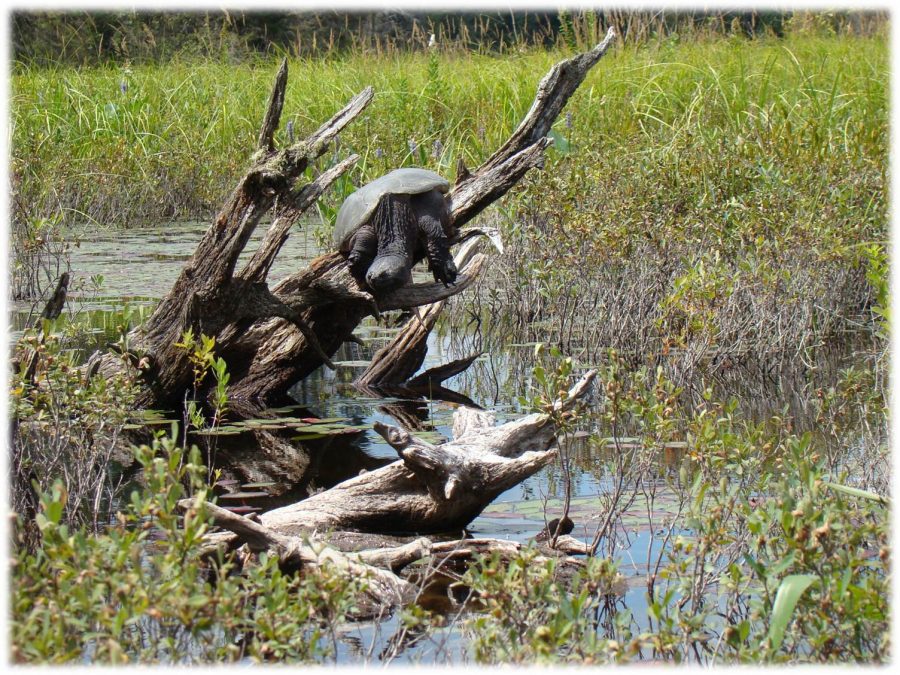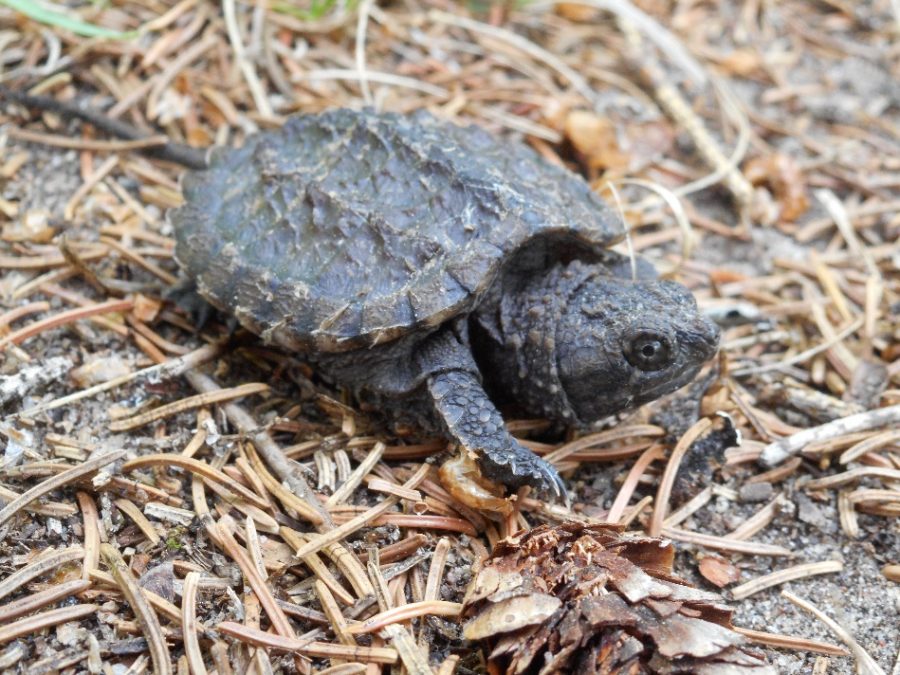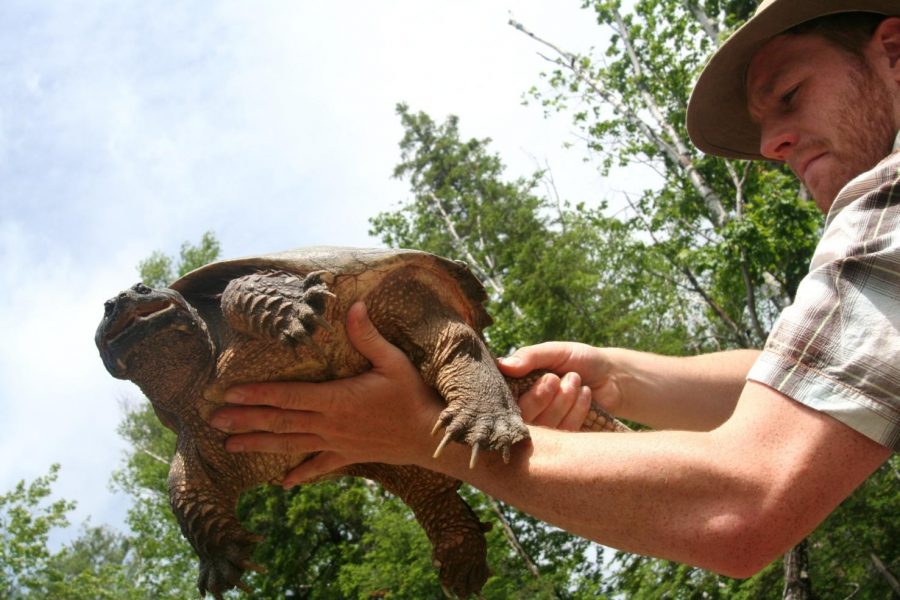Today’s post comes from David LeGros, a Natural Heritage Education Specialist at Algonquin Provincial Park.
I spent most of my youth in rubber boots and obsessed with nature. I was always looking for interesting animals and plants.
There are a few creatures then, just like now, that always inspire me.
Top of my list: the Snapping Turtle.
The snapper’s size

Seriously, how can you not be impressed? This enormous reptile has a huge dark shell covered in algae, a long spiky dinosaur tail, paws the size of your hands and a long neck with a big head that can lunge lightning fast at a threat or food.
The physical presence of a big snapper is truly awe-inspiring. However, if this is the only reason we are impressed by one, we are simply judging a book by its cover.
 Once, from a remote backcountry campsite, I got to watch a huge male snapper swim past; he was like an aquatic ballerina wearing a suit of armour — so graceful and weightless.
Once, from a remote backcountry campsite, I got to watch a huge male snapper swim past; he was like an aquatic ballerina wearing a suit of armour — so graceful and weightless.
It was hard to imagine what this turtle may have seen in his life. Maybe he was around for the establishment of Algonquin Provincial Park in 1893. Since then, he’s watched log drivers pushing white pine down rivers, celebrated Canada’s centennial, and totally ignored the rise of the Biebs.
I was enthralled with snappers before, but after this sighting, I became an impassioned advocate for turtles.
Oh, snap!
First things first: we need to get past the snapper’s snap.

Unlike most turtles, which have both a hard and protective upper and lower shell (carapace and plastron), the snapper has a normal upper shell, but only a tiny lower shell, which leaves its fleshy legs exposed. That is why when you encounter most other turtles on land, they withdraw to the protection of the shell.
Snappers will stand their ground, and may snap in your direction. The best thing to do is leave them alone. Turtles aren’t very fast when they are out of the water, and feel more vulnerable there than anywhere else.
Big snappers are survivors

It takes a very long time for a Snapping Turtle to reach adulthood, about 20 years. They continue to grow slowly their entire lives, and may have a shell length of over 30 cm. Some will even reach 40 cm+!
Snapping Turtles can weigh up to 20 kg – truly enormous. At this size, the turtle might be very old, perhaps well over 100 years.
Unlike many other turtle species, male snappers are bigger than females. This is because males fight over females, and the bigger you are the more powerful rival you are.
A mother snapper carefully chooses her nest

Some female Snapping Turtles may travel up to 8 km – one way – to find a suitable nest site. They swim across lakes or through a river, and even face danger by travelling over land.
At the nesting site, usually a sunny and sandy place, she digs a hole with her back feet (all without looking!) and deposits her 20-40 eggs in the damp sand. After she buries them, she’s done. The sun warms the sand and incubates them.
Don’t hold your breath!
When you live in the water, eventually you’ll have to hold your breath. A Snapping Turtle is a champion at this skill.
As a cold-blooded reptile, its metabolism is already low, so its oxygen needs are much lower than a mammal of the same size. This means it can hold its breath for quite a while, well over 10 minutes.

In the winter, the turtles hibernate under the ice, which means they cannot access the surface for a breath.
What happens then?
Well, as the temperature drops, so does the turtle’s need for oxygen. It finds a place on the bottom of the lake or pond, maybe wedged between rocks or logs, or under-cut bank. It spends the winter here without drawing a breath, which could be up to six months!
It does have a secret weapon – its bum. Taking in small amounts of water through its cloaca (turtle bum), it can absorb a little bit of oxygen from the water, and release carbon dioxide this way.
Turtles need your help!
Turtles do need to get from one place to another to nest, find food, mates or a hibernation spot. Sometimes, they cross a road.

Despite all their neat adaptations, they do not know how to look both ways before crossing a road. Besides that, it might not help if they did; they are slow moving. Many get hit by cars every year in Ontario, even in protected places like provincial parks.
If you see one crossing the road, you can help it by:
- Carefully picking up by the rear of the shell (never the tail) and moving it across the road
- Watching it and making sure it makes it across safely on a quiet road
- Coax it into a box, tub, or onto a blanket and drag it across the road
Always make sure the road is clear and it is safe to do so. You don’t want to end up roadkill yourself. Always bring it in the direction it was travelling; they know where they are going.

A Snapping Turtle nesting on the shore or cruising past a campsite is an amazing encounter with a wild animal. Their unique adaptations, huge size and long lives make them one of the most amazing creatures on our landscapes.
I feel like they are an iconic creature of our wild places, and serve as a reminder of a time long ago and inspiration to protect wilderness in the long-term.
